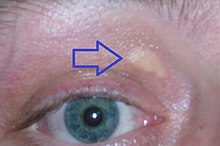
Back فرط كوليسترول الدم العائلي Arabic Hipercolesterolèmia familiar Catalan Οικογενής υπερχοληστερολαιμία Greek Hipercolesterolemia familiar Spanish هیپرکلسترولمی فامیلی Persian Familiaalinen hyperkolesterolemia Finnish Hypercholestérolémie familiale French היפרכולסטרולמיה משפחתית HE Obiteljska hiperkolesterolemija Croatian Hiperkolesterolemia familia ID
| Familial hypercholesterolemia | |
|---|---|
| Other names | Familial hypercholesterolaemia |
 | |
| Xanthelasma palpebrarum, yellowish patches consisting of cholesterol deposits above the eyelids. These are more common in people with FH. | |
| Specialty | Endocrinology |
Familial hypercholesterolemia (FH) is a genetic disorder characterized by high cholesterol levels, specifically very high levels of low-density lipoprotein cholesterol (LDL cholesterol), in the blood and early cardiovascular diseases. The most common mutations diminish the number of functional LDL receptors in the liver or produce abnormal LDL receptors that never go to the cell surface to function properly (abnormal trafficking).[citation needed] Since the underlying body biochemistry is slightly different in individuals with FH, their high cholesterol levels are less responsive to the kinds of cholesterol control methods which are usually more effective in people without FH (such as dietary modification and statin tablets). Nevertheless, treatment (including higher statin doses) is usually effective.
FH is classified as a type 2 familial dyslipidemia.[1] There are five types of familial dyslipidemia (not including subtypes), and each are classified from both the altered lipid profile and by the genetic abnormality. For example, high LDL (often due to LDL receptor defect) is type 2. Others include defects in chylomicron metabolism, triglyceride metabolism, and metabolism of other cholesterol-containing particles, such as VLDL and IDL.
About 1 in 100 to 200 people have mutations in the LDLR gene that encodes the LDL receptor protein, which normally removes LDL from the circulation, or apolipoprotein B (ApoB), which is the part of LDL that binds with the receptor; mutations in other genes are rare but important to know, including gain-of-function mutations in PCSK9, the molecular "scissor" of LDL receptors, resulting in less LDLR available. PCSK9 mutations cause less than 5% of cases of FH according to most epidemiologic studies.[2] People who have one abnormal copy (are heterozygous) of the LDLR gene may develop cardiovascular disease prematurely at the age of 30 to 40. Having two abnormal copies (being homozygous) may cause severe cardiovascular disease in childhood. Heterozygous FH is a common genetic disorder, inherited in an autosomal dominant pattern, occurring in 1:250 people in most countries;[3] homozygous FH is much rarer, occurring in 1 in 300,000 people.[citation needed]
Heterozygous FH is normally treated with statins, bile acid sequestrants, or other lipid-lowering agents that lower cholesterol levels. New cases are generally offered genetic counseling. Homozygous FH often does not respond to medical therapy and may require other treatments, including LDL apheresis (removal of LDL in a method similar to dialysis) and occasionally liver transplantation.[4]
- ^ Pejic RN (2014). "Familial Hypercholesterolemia". Ochsner Journal. 14 (4): 669–72. PMC 4295745. PMID 25598733.
- ^ Goldberg AC, Hopkins PN, Toth PP, Ballantyne CM, Rader DJ, Robinson JG, Daniels SR, Gidding SS, de Ferranti SD, Ito MK, McGowan MP, Moriarty PM, Cromwell WC, Ross JL, Ziajka PE, National Lipid Association Expert Panel on Familial H (June 2011). "Familial hypercholesterolemia: screening, diagnosis and management of pediatric and adult patients: clinical guidance from the National Lipid Association Expert Panel on Familial Hypercholesterolemia". Journal of Clinical Lipidology. 5 (3 Suppl): S1–8. doi:10.1016/j.jacl.2011.04.003. PMID 21600525.
- ^ Akioyamen LE, Genest J, Shan SD, Reel RL, Albaum JM, Chu A, et al. (2017). "Estimating the prevalence of heterozygous familial hypercholesterolaemia: a systematic review and meta-analysis". BMJ Open. 7 (9): e016461. doi:10.1136/bmjopen-2017-016461. PMC 5588988. PMID 28864697.
{{cite journal}}: CS1 maint: multiple names: authors list (link) - ^ Cite error: The named reference
Rader2003was invoked but never defined (see the help page).
© MMXXIII Rich X Search. We shall prevail. All rights reserved. Rich X Search